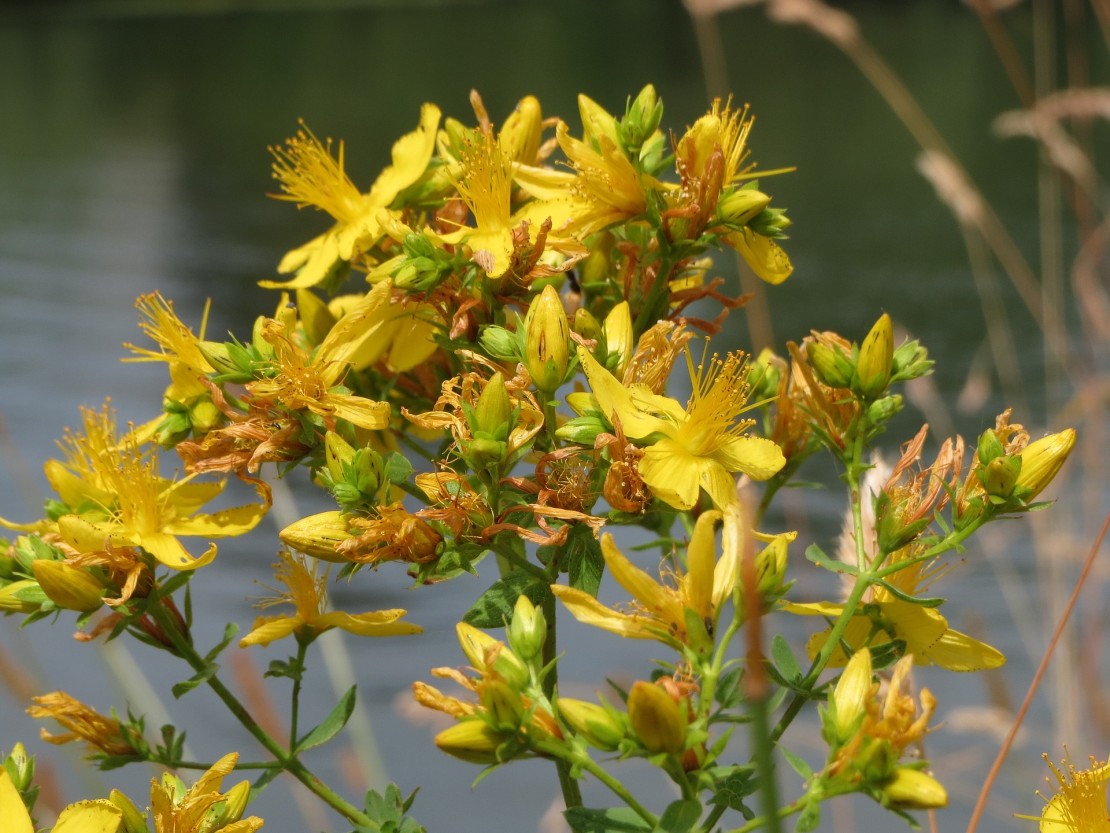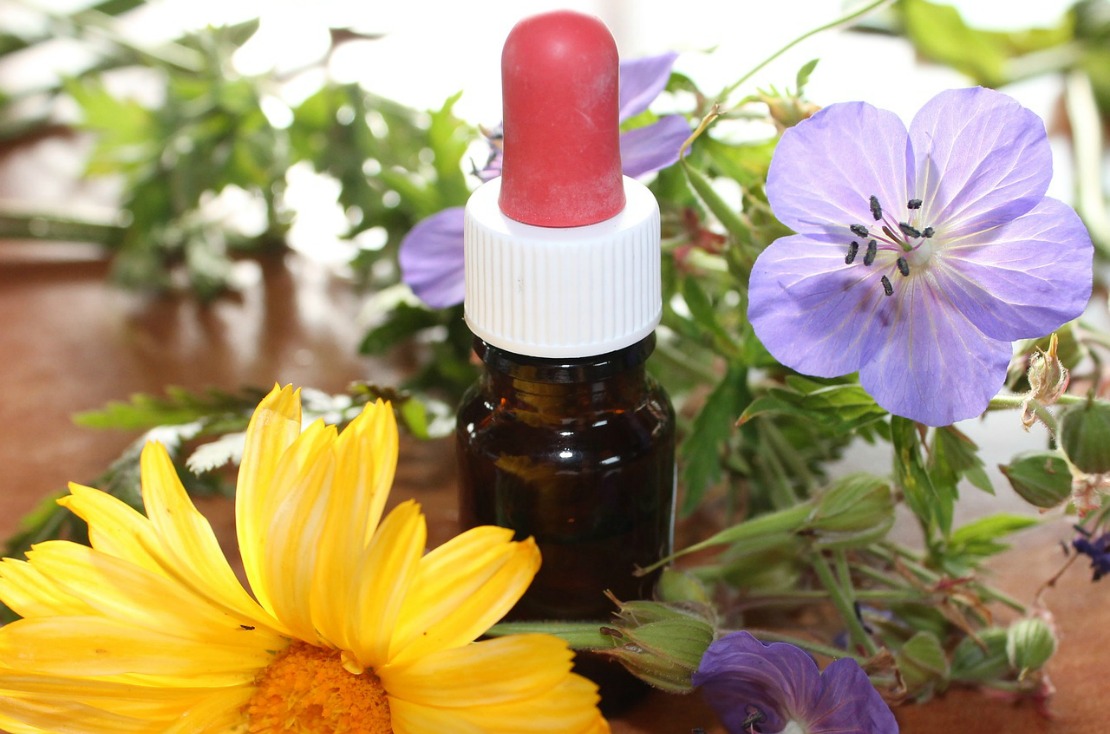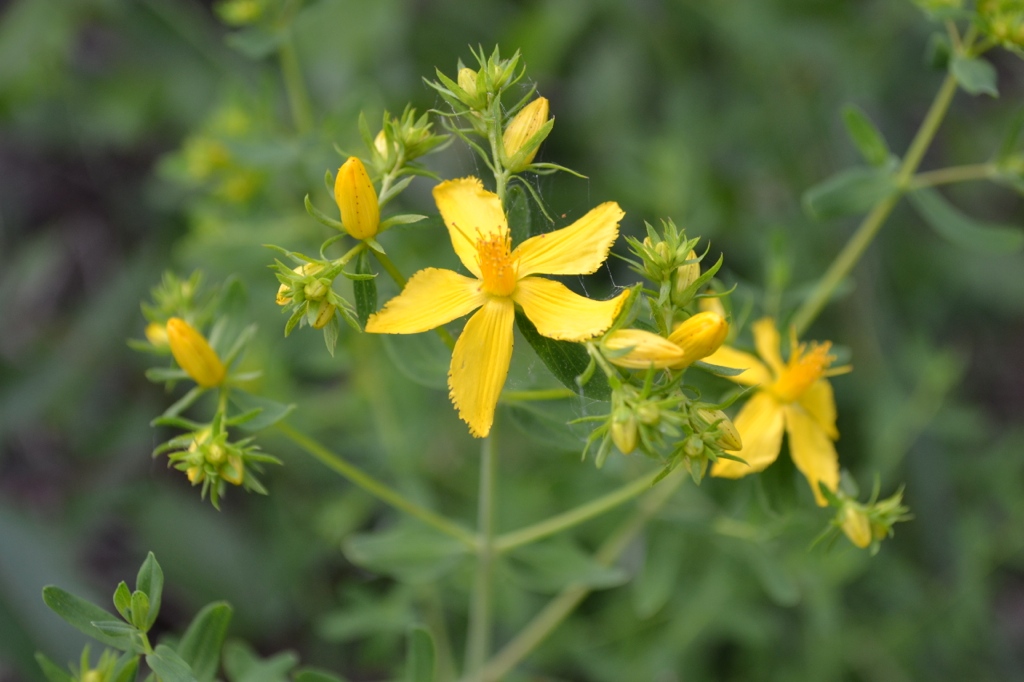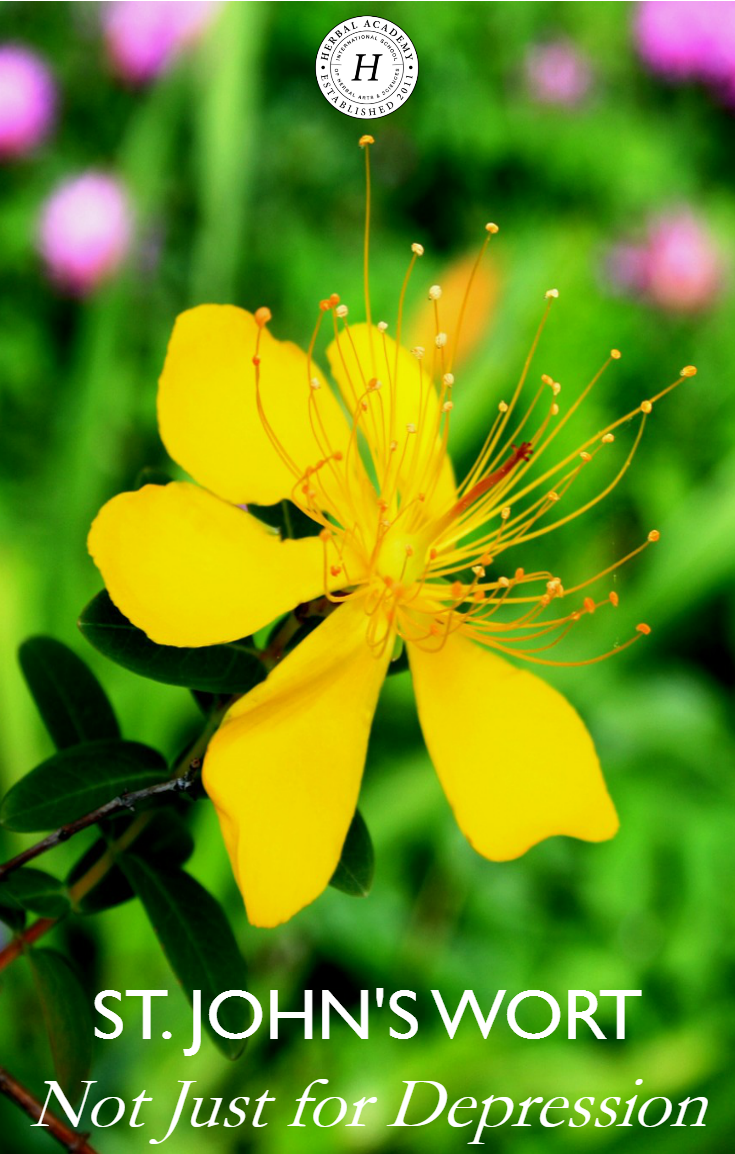
St. John’s Wort: Not Just For Depression
Stumbling upon a field of wildly growing St. John’s wort (Hypericum perforatum) is like discovering a ray of Earth-bound sunshine. Profuse bright, happy yellow flowers hint at this plant’s well-known use for soothing those suffering from depression. Yet, those cheery flowers hold many more herbal actions and uses within than most of us are familiar with! The traditional uses and benefits of St. John’s are numerous – this plant really is not just for depression! In fact St. John’s wort is known among herbalists as a wonderful herb for supporting and soothing the body in numerous ways!
The five-petaled flowers are a lovely, vivid yellow that when crushed release a reddish purple oil. And when fresh St. John’s wort is made into an infused oil or tincture, the menstruum turns a beautiful red color. Another interesting feature of this plant is its leaves. When held up to the light of the sun, little dots of light shine through the leaves giving the appearance of tiny holes, hence the species name “perforatum.”
A Good Friend Indeed
This amazing plant is a nervine with a scope beyond depression and was traditionally used as a plant for the nervous system long before recent research has explored its use for depression. St. John’s wort was used as a nervous system trophorestorative acting as a tonic to deeply balance and nourish the nervous system restoring health (LaLuzerne, 2013).
This beautiful herb brings light to many issues of the nervous system and is used by herbalists to help ease anxiety, tension, neuralgias, seasonal affective disorder, and indeed, mild to moderate depression. Beyond emotional support, St. John’s wort is also used to help relieve physical tension and pain.
Eases Pain
“When injuries to the nerves are involved, [St. John’s wort] is often among the most beneficial and broadly acting herbs available. It is appropriate for conditions ranging from sciatica to atrophy of nervous tissue, and also often relieves the pain of sore muscles” (McDonald, n.d., para. 26).
Many herbalist turn to St. John’s wort to help soothe and ease pain. Herbalist Mary Bove explains that “St. John’s wort is known for helping to diminish pain” both externally or internally (LaLuzerne, 2013). Specifically indicated for trauma and damage to the nervous system whether through injury or viral infection, St. John’s wort is the herbalist go-to for painful issues such as neuralgias, sciatica, Bell’s palsy, head and spine trauma, pinched nerves, after surgical and dental work, as well as injuries to any area that is rich in nerve endings (Winston, 2007; LaLuzerne, 2013; McIntyre, 1996).
St. John wort’s ability to help soothe nerves combined with its antiviral actions make this plant a wonderful ally for anyone dealing with the pain of shingles as well as herpes infections.
As an antispasmodic, St. John’s wort helps to relax muscles spasms including spasms in the lungs, colon, and reproductive tract. This helps to soothe the pain of digestive spasms and menstrual cramps as well as to ease spasmodic coughing. Also, St. John’s wort is wonderful to turn to when muscles are sore from over-exertion easing shoulder, neck, and back pain (LaLuzerne, 2013).

Soothing Topical Uses
St. John’s wort’s ability to soothe the nerves is beloved among herbalists who enjoy using the fresh plant oil topically to ease nerve pain. Herbalist Rosemary Gladstar explains that this beautiful herb is “primarily valued as treatment for damage to the nerve endings” (Gladstar, 2001, p. 360).
Michael Moore explains that St. John’s wort benefits the skin in wound repair “as it stimulates granulation and capillary regeneration, as well as having substantial antibacterial effects” (Moore, 1993, p. 155). The fresh oil is used by herbalists as a vulnerary and anti-inflammatory that helps to hasten healing and soothe the pain of burns, cuts, wounds, insect bites, and even varicosities such as hemorrhoids and varicose veins as well as bruises, strains, and muscle pain (McIntyre, 1996; Winston, 2007). It is also wonderful as an antiviral and analgesic for ear drops (LaLuzerne, 2013).
Strengthens the Seat of Personal Power
Herbalist Matthew Wood explains that St. John’s wort has “a particularly affinity for the solar plexus and the nerves of digestion” and it “strengthens the action of the solar plexus” (Wood, 1997, p. 313). And indeed we find that St. John’s wort benefits and supports the organs that correspond to the solar plexus or third chakra area such as the liver and gallbladder, digestive tract, and kidneys. This propensity “will help improve the overall condition of the whole body as it works to tone the vital organs” (Adelmann, n.d., para. 13).
Here traditional use brings us insight yet again! Herbalists used to look to St. John’s wort to support the liver as a both a tonic and a cholagogue helping to stimulate bile flow aiding in the digestion and assimilation of nutrients (Bergner, 2001). Furthermore, the astringency and antimicrobial properties from St. John’s wort also aid in re-balancing the digestive tract during gastrointestinal upset such as diarrhea and dysentery (McIntyre, 1996).
This amazing plant also exhibits a diuretic action that helps to promote waste and fluid removal while at the same time exhibiting a tonic effect on the urinary system easing incontinence and even helping with bedwetting in children (McIntyre, 1996).
Supports the Immune & Respiratory Systems
You may be surprised to find that the benefits of St. John’s wort even extend to the immune and respiratory systems. As an antiviral, expectorant, and anti-inflammatory, St. John’s wort is wonderful for soothing discomfort during illness and helping to fight infection (McIntyre, 1996). Think of St. John’s wort when faced with illnesses that are caused by viruses such as the common cold and the flu!
A Woman’s Ally
St. John’s wort can be a useful herb during menopausal transition to help soothe emotional upheaval (McIntyre, 1996). In fact it is “considered especially appropriate for use when menopausal changes trigger irritability and anxiety” (Hoffmann, 2003).
While this lovely plant can be useful for women transitioning later in life, it is also helpful when we, as women, are in the thick of things. St. John’s wort’s pain relieving properties along with its ability to help relax the nervous system make it useful during bouts of PMS and painful menstruation (McIntyre, 1996). Midwife and herbalist Ruth Trickey explains that St. John’s wort is “indicated in conditions where exhaustion and tension combine—a common finding in women who present with hormonal problems” (Trickey, 1998, p. 360).

Happy Combinations & Uses
St. John’s wort blends well with a myriad of herbs depending on how you want to enjoy the wonderful support this herb offers. Blend this lovely herb with other plants to create tinctures, cordials, teas, oils, and salves!
- Chamomile: for nervous stomach caused by stress or during emotional turmoil especially in the young (Gladstar, 1999)
- Lemon balm: for seasonal affective disorder or depression (Winston, 2007; Gladstar, 1999)
- Passionflower: during times of stress and anxiety (Gladstar, 1999)
- Hops & Valerian: for trouble sleeping (Gladstar, 1999)
- Poplar buds & Arnica: for topical use (Moore, 1993)
- Garlic & Mullein: add to ear oil to help with infections and pain.
Which St. John’s Wort? Fresh or Dried?
Most herbalists will agree that the best preparations of St. John’s wort are made from the fresh plant. Research into St. John’s wort to isolate the active constituents of this plant has been inconclusive and most herbalists agree that preparations such as tinctures and infused oils made from the fresh form of this plant are superior to anything you can find isolated or dried at the grocery store (Gladstar, 2001).
Tincture made from fresh flowering tops (1:2 or 1:5) can be taken in doses of 40 to 60 drops 3 to 4 times per day (Winston, 2007).
If working with the dried herb, tea can be made by steeping 2 to 3 teaspoons of herb per cup of water in a covered vessel for 30 minutes. Strain and drink up to 2 cups of this throughout the day (Winston, 2007).
Playing it Safe
Safety concerns have arisen over use of St. John’s wort. As discussed above, this plant stimulates liver detoxification, and therefore, will reduce the clearance time for certain pharmaceuticals so please check with knowledgeable herbalist or pharmacist before taking St. John’s wort with prescription drugs (Winston, 2007). St. John’s wort may cause photosensitivity and should not be used during pregnancy without professional guidance.
The uses and benefits of St. John’s wort are many – what a gift this happy, sunny plant is to us!
Would you like to learn more about St. John’s wort and many other amazing herbs? Join us in The Herbarium where you will have access to herbal knowledge right at your fingertips!

REFERENCES
Adelmann, M. (n.d). St. John’s Wort. Retrieved on 4/09/17 from http://www.fromscratchmag.com/st-johns-wort/
Bergner, P. (2001). Hypericum, drug interactions, and liver effects. Medical Herbalism 11(2):16-20.
Gladstar, R. (1999). Herbs for reducing stress & anxiety. Pownal, VT: Storey Books.
LaLuzerne, D. (Producer). (2013, October 23). DIY herbs: St. John’s wort with David Hoffmann, Sharol Tilgner, Susun Weed and Mary Bove [Audio podcast]. Herb TV. Retrieved from https://www.youtube.com/watch?v=e3pKkaYJjNU
Hoffmann, D. (2003). Medical herbalism. Rochester, VT: Healing Arts Press.
McDonald, J. (n.d.). Indications for Commonly Used Herbs… Retrieved on 4/11/17 from http://www.herbcraft.org/commonherbs.html
McIntyre, A. (1996). Flower power. New York, NY: Henry Holt and Company.
Moore, M. (1979). Medicinal plants of the Pacific West. Sante Fe, NM: Museum of New Mexico Press.
Moore, M. (1993). Medicinal plants of the mountain West. Sante Fe, NM: Red Crane Books.
St. John’s Wort Monograph. (n.d.). Retrieved on 4/10/17 from http://herbarium.theherbalacademy.com/monographs/#/monograph/3038
Trickey, R. (1998). Women, hormones and the menstrual cycle. Australia: Allen & Unwin Winston
Winston, D. (2007). Adaptogens: Herbs for strength, stamina, and stress relief. Healing Arts Press.
Wood, M. (1997). The book of herbal wisdom. Berkeley, CA: North Atlantic Books.








